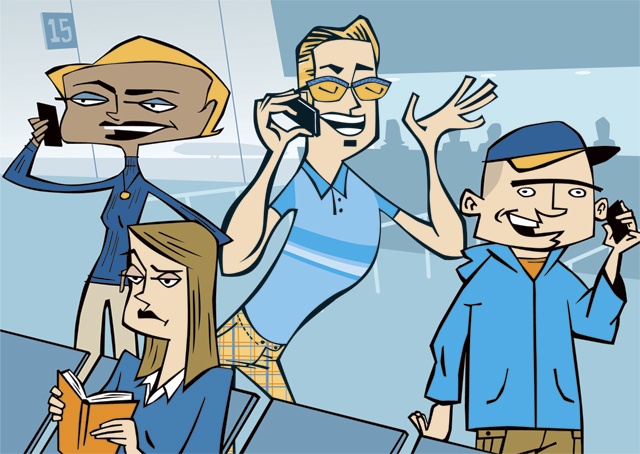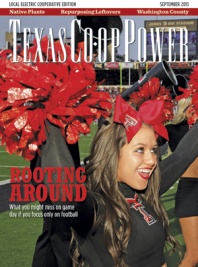Four hours before my scheduled flight home from San Diego International Airport, I’m lonely, hungry and mentally exhausted from listening to people’s cellphone conversations. Poor planning led to this long wait on a March morning dragging into afternoon, and right now, Austin seems a million miles away.
I feel disconnected as I listen to people yammer on and on in cryptic cellphone sound bites. It’s maddening listening to partial conversations. I can’t concentrate on reading my book, and napping is out of the question. My head’s about to explode from sensory overload.
Looking around the crowded terminal at phones stuck to people’s ears like plastic appendages, I’m not so sure that we resemble an evolving species. Our so-called smartphones aren’t making us look very intelligent as we text with thumbs, like cave people learning the first strokes of communication.
But watching other people text is just that: I can look away, unaffected. I’m not involved against my will. End of story. Cellphone conversations, meanwhile, are a story with no end. I miss the intimacy of pay phones. People spoke quietly, keeping the conversation appropriately private. Now, at rude, megaphone-loud levels, we hear the minutiae of each others’ lives.
Yet I’m confused as to why that bothers me so much. As a longtime urbanite, I’m acclimated to ambient noise: barking dogs, sirens, traffic. So why can’t I handle all this yakking? As it turns out, there’s a logical explanation. A research report published in the October 2010 issue of the journal Psychological Science makes the case that overhearing “halfalogues”—one half, or one side, of a cellphone conversation—annoys and distracts us.
The report details experiments in which participants performed simple computer-screen tasks after listening to recordings of a cellphone conversation. Hearing dialogue or monologue speeches, the latter of which recapped the entire conversation, did not hurt task performance. But hearing halfalogues significantly decreased performance.
The reason, submit the report’s authors, is that the less predictable speech of halfalogues creates confusion and inattentiveness.
No wonder I’m so hung up on escaping cellphone conversations. In San Diego, an hour before my flight, I land a seat in a mostly deserted section next to my gate. I stretch and survey my surroundings. Wait. What was that? I whip my head back around, doing a double take at a husband, wife and teenage daughter sitting with two strange, exotic-looking animals.
In the woman’s lap sits a small, fuzzy-headed creature with long, jackrabbit-sized ears. Is it a farm animal? Maybe a goat? My mind struggles to process the visual. The other, larger animal looks like a dog. But he’s unlike any dog I’ve ever seen, with gray, hairless skin, upright ears and the regal stance of a king.
Intrigued, I approach the family: What on earth are these animals? The answer, for both: Xoloitzcuintli, an ancient Aztec dog breed I’ve never heard of and sure can’t pronounce (it’s show-low-eats-queen-tlee).
With permission, I pet the larger dog, 2-year-old Miguel, whom the family has just purchased from a breeder in Tijuana, Mexico. Miguel’s skin feels like soft, rubbery leather, and his dark eyes bore into me, as if he’s plumbing mysteries I don’t know exist. I reach out my hand to the shy Hermanita, a 4-month-old puppy who’s hairless save for the scruffy patch on her head.
I walk away, but then glance back. A crowd has gathered around Miguel and the teenage girl. There’s both a tenderness and an otherworldliness to this muscled dog standing as still as a stone sculpture while a baby girl pats his head.
Suddenly, I’m fully engaged. I grab my reporter’s pad. A Southwest Airlines pilot, the same co-pilot who will help fly me home, asks to see the breed’s spelling on my yellow legal paper. People pull out cellphones, not to make calls, but to take pictures of Miguel. I officially meet the teenage girl, Kayla Wise, and her parents, United Cooperative Services members Paul and Amy Wise, who raise show dogs on a ranch near the North-Central Texas town of Hico.
This is Miguel’s first flight, and his pink harness bearing white lettering—ESA, for emotional support animal—partially tells his story: He’ll be trained for the show ring, but today, he’s serving as an ESA for Amy, who experiences anxiety when flying. Baby Hermanita, who’s making her second flight with Amy, is also filling a support role: The 3,500-year-old Xolo breed, known as the first dog of the Americas, is legendary for its uncanny ability to comfort and pick up on emotion and energy.
At long last, we board our plane bound for Texas. The Wise family claims the front left row. Miguel, the older dog, sits in front of teenager Kayla, who’s five days from her 16th birthday. Hermanita sits in Amy’s lap, in the middle. Husband Paul takes the aisle seat, fielding questions about the dogs.
I settle in 14 rows back, in front of the baby girl who petted Miguel. Finally comes the message I’ve waited all day to hear: “Please turn off all electronic devices.” Face-to-face conversation bubbles around me. I turn around and meet the baby, 1-year-old Maya, and her parents. Maya flirts with everyone who walks down the aisle. At 30,000 feet, a woman headed to the restroom stops to play peekaboo with the precious baby girl.
Up front, Amy relaxes by rubbing lotion into Hermanita’s skin. Miguel, who instinctively placed his head in Amy’s lap during takeoff, sits in silent protection of his new family as two flight attendants admire the dogs.
After we land in Austin, the co-pilot steps out of the cockpit to chat more with the Wise family. I’m home, but the Wises have one more stop, in Dallas. I say goodbye, clearing the way for new passengers on this connecting flight. I turn my cellphone on, feeling energized, alive and ready to communicate.
——————–
Camille Wheeler is an Austin writer.


